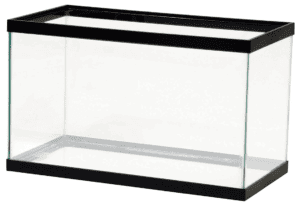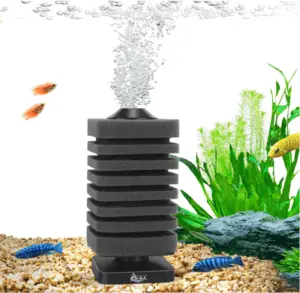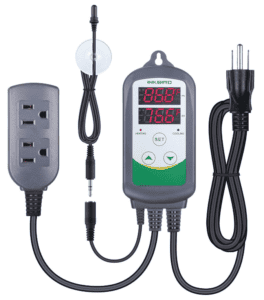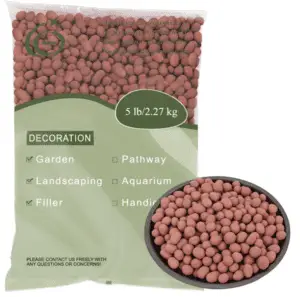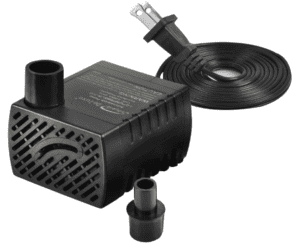According to aquaponics guru John, “Aquaponics combines fish farming and crop cultivation in a symbiotic loop.”
You’ll need a fish tank, grow bed, water pump, plumbing, lights, and fish and plants that thrive together.
Purchase ready-made components or build your own to suit your space.
Once set up, this closed ecosystem feeds plants with nutrients from fish waste and returns clean water to the tank.
Maintaining ideal water quality keeps both fish and plants healthy.
Curious to learn more? Keep reading this guide to discover step-by-step aquaponics instructions.
You’ll get insider tips on choosing fish and crops, proper system sizing, and troubleshooting issues like pH fluctuations.
Whether starting small or investing in a large setup, you’ll find helpful advice for sustaining a productive aquaponics garden that serves up fresh fish and veggies.
KEY TAKEAWAY
How to set up aquaponics?
Setting up aquaponics involves combining fish farming and plant cultivation in a mutually beneficial system, providing an eco-friendly and efficient way to grow both fresh produce and fish. (1)
Getting Started with Aquaponics: A Beginner’s Blueprint
Dreaming of having your own aquaponics system that effortlessly grows fish and vegetables together?
Getting started with aquaponics (2) may seem complicated, but the basic premise is simple.
An aquaponics system recycles water between a fish tank and a grow bed.
The fish waste provides organic nutrients to fertilize the plants.
The plants then filter and clean the water before it flows back to the fish.
It’s a balanced ecosystem that sustains both components.
When setting up your first aquaponics system, start small and focus on the essential elements:
- Fish tank – Houses fish like tilapia or catfish that thrive in warm water. Allow 1 gallon per 1 inch of fish length.
- Grow bed – Contains growing media like gravel. Plants grow here instead of soil. Size for 1 square foot per expected fish weight.
- Water pump – Transfers water between fish tank and grow bed. Match flow rate to system volume.
- Plumbing – Flexible tubing that connects the system components in a loop.
- Seeds/seedlings – Fast-growing leafy greens, herbs and vegetables.
- Grow light – LED full spectrum lights simulate sunlight for indoor systems.
Monitoring water quality and nutrients carefully in the beginning ensures your fish stay healthy while plants establish roots.
Test for pH, ammonia, nitrites and nitrates with test kits.
As you gain experience, you can expand by adding extra grow beds, more fish, and experimenting with automatic bell siphons or raft systems.
The possibilities are endless!
Understanding the Core of Aquaponics: How Does It Work?
Aquaponics harnesses natural biological processes to produce two valuable crops – fish and plants – in the same recirculating system.
But how does it actually work?
The key lies in the nitrogen cycle.
Fish feed provides protein for growth and development.
As fish metabolize this feed, they produce waste containing ammonia.
Too much ammonia can be toxic, but beneficial bacteria convert it first into nitrites, then into nitrates.
These nitrates happen to be perfect plant food!
Plants thrive on the nitrate-rich water from the fish tank.
As the plants absorb nutrients, they act as miniature water filters.
Their roots provide surface area for helpful bacteria to grow.
These bacteria further break down any ammonia and nitrites into safer nitrate.
After passing through the grow bed, the cleaned water returns to the fish tank via gravity or a water pump.
The fish stay healthy in the filtered water while plants get to feast on the nutrients from fish waste.
It’s a beautifully efficient cycle where both components help each other survive and thrive!
An aquaponics system relies on maintaining balance between the nutritional needs of fish, plants and bacteria.
Careful monitoring of water quality parameters like pH, ammonia, nitrites and nitrate helps catch any fluctuations that could endanger fish.
Testing and correcting water issues promptly keeps the ecosystem in equilibrium.
With a grasp of the underlying science, you can better understand common aquaponics management practices.
Fine-tuning your system gets easier when you know how the nitrogen cycle directly impacts the health of fish, plants and bacteria.
Choosing the Right System: Types of Aquaponics Explained
When starting your aquaponics journey, one key decision is what type of system to build.
The main options come down to media-based, raft, NFT (nutrient film technique), or hybrid systems.
In a media-based setup, plants are grown in an aggregate medium like gravel or clay pebbles within the grow bed.
The fish tank water cycles through to irrigate plant roots and provide nutrients.
Media beds allow helpful bacteria to colonize and are great for beginners.
Raft or DWC (deep water culture) systems suspend plants in floating rafts directly on water from the fish tank.
No growing media is used.
The raft allows plant roots to access nutrient-rich water while keeping the top foliage dry.
NFT channels feature a very shallow stream of water that flows through PVC pipes or gutters past plant roots.
This ultra-efficient system demands careful monitoring to avoid drying out plant roots.
Finally, hybrid aquaponics combines two or more system types like media beds plus DWC rafts.
This provides flexibility to grow different plants according to their preferences and maximize space efficiency.
When deciding on your setup, factor in available space, budget, the types of plants you want to grow, and how hands-on you plan to manage it.
Leafy greens thrive in raft systems while fruiting plants often prefer media beds.
Match your system design to your goals for the healthiest, most productive aquaponic garden!
Critical Components: Building Blocks of Your Aquaponic Setup
While aquaponics relies on some advanced science, you can break down system building blocks into core components.
Ensuring each element is appropriately sized and integrated is key for smooth functioning.
- The centerpiece is the fish tank which houses warm water species like tilapia, catfish or koi. Allow at least 1 gallon capacity per 1 inch of adult fish length. Rectangular tanks maximize water volume but round ones require less surface cleaning.
- Include aeration, filtration and temperature control matched to stocking density.
- Next up are grow beds, the plant nursery of your aquaponics system. At a minimum, plan 1 square foot of grow area per 1 pound of fish weight. Beds can be constructed from wood, plastic containers or lined ponds.
- Fill with growing media like expanded clay to support plants while filtering water.
- A water pump circulates water between the fish tank and grow beds. It should be rated for at least the total system volume per hour. Flexible tubing or PVC piping connects components in a closed loop.
- Additional elements like seed starters, grow lights or automatic bell siphons enhance system performance but aren’t strictly essential at first.
Focus resources on the foundational triad of robust fish housing, adequately sized plant beds and water circulation to create a balanced aquaponics environment.
Fish and Plants Harmony: Selecting the Perfect Aquaponic Partners
The key to a thriving aquaponics system is choosing fish and plant partners that flourish together.
Select fish species that enjoy warm water while pairing them with fast-growing, nutrient-hungry crops.
When stocking your fish tank, popular picks include tilapia, koi, goldfish, catfish and carp.
Most freshwater fish with hearty appetites work well.
Allow at least 10 gallons of tank capacity for a medium-sized fish.
Provide ample aeration, filtration and regular feeding to keep them vigorous.
For your media beds or raft setup, focus on quick-growing greens, herbs and vegetables.
Lettuce, kale, chard, basil, chives and green onions make excellent starter plants.
As your system matures, experiment with fruiting plants like tomatoes, peppers, beans, strawberries and cucumbers.
The plants filter nitrates from fish waste while removing solids and refreshing the water.
In exchange, they absorb a rich cocktail of nitrogen, phosphorus and potassium to turbocharge growth.
Pay close attention to any imbalances, such as ammonia spikes from overfeeding fish or nutrient deficiencies slowing plant development.
Make adjustments as needed to maintain equilibrium between the biological components.
With healthy, happy fish continuously supplying nutrients and vigorous plants cleansing the water,
You’ll reap simultaneous harvests of fresh veggies and protein-packed fillets from a symbiotic aquaponic system!
Step-by-Step Setup Guide: From Tank to Harvest
Ready to build your own aquaponics system? Follow this beginner’s guide to fundamental setup steps, from assembling components to nurturing your first crops.
- Start by installing and leveling your fish tank or basin.
- Opt for food-grade materials without harmful chemicals that could leach.
- Position it near a power source and where you plan to situate your grow bed.
- Next, prepare the media bed that will house your plants.
- Construct a sturdy wooden frame or fill a plastic tub with growing media like expanded clay pellets.
- Include drainage ports to connect plumbing.
- Run flexible tubing or PVC pipes between the grow bed and fish tank to complete the closed-loop circuit.
- Install a water pump appropriately sized to your system volume to circulate water.
- Now add a few hearty fish like tilapia or catfish, allowing at least 10 gallons per fish.
- Use an air pump and test water parameters like pH, ammonia and temperature to ensure ideal conditions.
- Let the tank cycle for 2-4 weeks before introducing young seedlings.
- Try quick-growing greens like lettuce, spinach and basil to start.
- Suspend lighting like LED grow lights above plants.
- Be diligent about testing and adjusting water chemistry, avoiding overfeeding fish, and maintaining equipment.
As your system stabilizes, continue adding fish and plants! In a few months, enjoy fresh, home-grown produce and fish fillets.
Maintenance Mastery: Keeping Your Aquaponic Ecosystem Thriving
An aquaponics system relies on diligent care and monitoring to enable the symbiotic relationship between fish and plants.
Regular maintenance prevents imbalances that could compromise your living ecosystem.
- At least twice a week, check on fish health and behavior.
- Remove any uneaten food within an hour to avoid fouling the water.
- Test ammonia, nitrites, nitrates and pH with a test kit and perform water changes as needed, replacing 10-15% at a time.
- Trim back plant roots protruding into fish tanks which can harbor bacteria.
- Prune and harvest mature plant growth to stimulate the next yield.
- Check for pest issues and treat them organically if found.
- Clear any clogged tubing and wipe algae or mineral buildup.
- Confirm water pumps are running properly and equipment functions aren’t impaired.
- Keep a detailed log tracking fish feedings, plant growth cycles, water parameter fluctuations and other observations.
This helps spot patterns for fine-tuning your system.
While aquaponics does require diligent effort, establishing consistent routines makes sustaining the ecosystem very manageable.
Hands-on care of your integrated fish farm and garden leads to productive harvests and a relaxing oasis of nature.
Beyond Basics: Tips for Expanding and Enhancing Your Aquaponic Garden
Once your starter aquaponics system is thriving, consider upgrades and expansions for even greater rewards.
From structural add-ons to technological augmentations, there are many possibilities!
If space allows, add extra grow beds or install vertical towers to boost plant capacity.
Supplement with more fish to generate additional nutrients and convert waste.
Scale up water pumps and filtration to match.
Try moving towards a hybrid setup with multiple grow bed types and raft tanks.
This increases the diversity of crops you can cultivate.
Introduce ornamental fish for visual appeal along with edible species.
For outdoor systems in cold climates, incorporate insulation or greenhouse enclosures to maintain ideal water temperatures year-round.
Invest in heating elements if needed to protect fish during winter.
Automate components like bell siphons for drainage cycles, automatic fish feeders, and monitoring systems tracking pH, ammonia and water levels.
This reduces manual labor while still providing alerts for prompt adjustments.
LED grow lights optimize indoor plant development.
In addition to plant and fish yields, explore revenue streams like aquaponic agritourism, selling seedlings, offering community classes, fee fishing and more!
Dream big and get creative with enhancements to your home aquaponics garden.
A customized ecosystem incorporating your personal vision and passion will bring you joy as well as sustenance.
Frequently Asked Questions
What types of aquaponics systems are there?
There are different types of aquaponics systems available like indoor aquaponics system, aquaponic systems, and media based aquaponics system.
The most common are media based aquaponics which use a grow media like gravel for the plants and flood and drain systems.
How do I build an aquaponics system?
There are many guides online that can help with building a DIY aquaponics system.
The basic components needed are a water tank for the fish, a grow bed with media for the plants, and a sump tank.
A bell siphon is also commonly used to control the flood and drain cycle.
Proper pH levels and water temperature also need to be maintained.
What kinds of fish can I use?
Some of the best fish for aquaponics include tilapia, koi, catfish and goldfish due to their waste output.
Be sure to monitor water parameters like ammonia, nitrite and nitrate levels.
Fish feeding is also important, so have a food grade fish food on hand.
What plants grow well in aquaponics?
Plants commonly grown include leafy greens like lettuce and herbs.
Other good choices include tomatoes, cucumbers, peppers and kale.
Starting seeds indoors first before transplanting gives them time to establish before being exposed to the nutrient rich water.
How do I maintain the system?
To keep the system balanced, it’s important to test the ph levels, remove solid waste that settles on the bottom, and partially change the water supply occasionally.
This exchanges fresh water for the nutrient rich water used by the plants and fish.
It’s also necessary to monitor the temperature is within the suitable range for both plants and fish.
How often should I change the water?
Most small DIY systems only need about 10-20% of the water changed out weekly.
Larger commercial systems may only need 5% changed monthly.
It’s best to test the water quality and change it more often if ammonia, nitrite or nitrate levels get too high for the fish and plants’ health.
What growing media is best?
The most common media used as a substrate for plant roots in aquaponics are gravel, clay pellets, and expanded clay pebbles.
They should all be washed thoroughly with water before use to remove dust and debris.
Food grade or child safe media is recommended.
Media based aquaponics works well as it filters and aerates the water for the fish and plants.
How do I get started with seed starting?
Starting seeds indoors in rockwool cubes, humidity domes or seedling trays allows them to sprout before being transplanted to the grow beds once they have a few sets of leaves.
This gives the roots a chance to develop before being exposed to the flood cycles and nutrient rich water in the main system.
What are the benefits of aquaponics?
Aquaponics offers several advantages over traditional soil based agriculture.
It uses up to 90% less water, recirculates nutrients efficiently in a closed system, and doesn’t require chemical fertilizers.
Both fish and plants can be raised together symbiotically with the fish waste providing nutrition for the plants.
Conclusion
Starting an aquaponics system may seem daunting but breaking it down into fundamental components makes the process very manageable.
With adequate housing for fish and plants, circulation between components, and balanced inputs, an amateur can sustain a modest ecosystem.
Monitor water quality, nurture your organisms, and make adjustments as needed in the early cycles.
As you gain experience, expand your system for increased productivity.
Incorporate creativity to make it uniquely yours.
Most importantly, enjoy the meditative routine while reaping wholesome homegrown food.
We’d love to hear your adventures with aquaponics in the comments!
References
- https://learn.eartheasy.com/articles/how-to-grow-with-aquaponics-in-5-simple-steps/
- https://gogreenaquaponics.com/blogs/news/what-is-aquaponics-and-how-does-it-work#:~:text=Aquaponics%20is%20a%20sustainable%20farming,%2Drich%20water%20without%20soil).
Related Articles
- https://tophydroponicgarden.com/what-to-plant-in-aquaponics/
- https://tophydroponicgarden.com/category/aquaponic/
- https://tophydroponicgarden.com/how-does-aquaponics-work/
Was this helpful?

I’m Barrie L., a passionate hydroponic gardening enthusiast dedicated to cultivating thriving, soil-less gardens. With a focus on all things hydroponic, I share my expertise on innovative growing techniques and sustainable practices through my blog, tophydroponicgarden.com. As a seasoned hydroponics specialist, my goal is to inspire and guide fellow gardeners in harnessing the power of water-based cultivation for bountiful and eco-friendly harvests. I’m also an author of the book “Hydroponics For Absolute Beginners: Your Step By Step Guide For How To Create An Hydroponics System At Home Without Soil, For Growing Vegetable, Fruit And Herbs.” which is sold on Amazon. Join me on a journey of redefining the way we cultivate plants, one nutrient-rich solution at a time. Happy growing!




